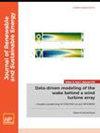Improving multi-state appliance classification by SE-DenseNet based on color encoding in non-intrusive load monitoring
IF 1.9
4区 工程技术
Q4 ENERGY & FUELS
引用次数: 0
Abstract
Non-intrusive load monitoring (NILM) is a technique that efficiently monitors appliances' operational status and energy consumption by utilizing voltage and current data, without intrusive measurements. In NILM, designing efficient classification models and building distinctive load features are crucial. However, due to its continuously variable load characteristics, multi-state load identification remains the most challenging problem in NILM. In this paper, we improve the encoding of the color V–I trajectory by incorporating instantaneous power, thereby enhancing the uniqueness of V–I trajectory features. Furthermore, we investigate a NILM method based on deep learning methods and propose a densely connected convolutional network with squeeze-and-excitation network (SE-DenseNet) architecture to solve the multi-state load identification problem. Initially, the architecture leverages DenseNet's dense connectivity property to generate a multitude of feature maps from the V–I trajectory. Then, SENet's channel attention mechanism is employed to enhance the utilization of effective features, which is more effective for multi-state load identification. Experimental results on the NILM public datasets PLAID and WHITED show that the recognition accuracy of the proposed method reaches 98.60% and 98.88%, respectively, which outperforms most existing methods.基于颜色编码的 SE-DenseNet 改进非侵入式负载监控中的多状态设备分类
非侵入式负载监控(NILM)是一种利用电压和电流数据有效监控电器运行状态和能耗的技术,无需侵入式测量。在 NILM 中,设计高效的分类模型和建立独特的负载特征至关重要。然而,由于负载的连续变化特性,多状态负载识别仍然是 NILM 中最具挑战性的问题。本文结合瞬时功率改进了彩色 V-I 轨迹的编码,从而增强了 V-I 轨迹特征的独特性。此外,我们还研究了一种基于深度学习方法的 NILM 方法,并提出了一种具有挤压-激励网络(SE-DenseNet)架构的密集连接卷积网络,以解决多状态负载识别问题。首先,该架构利用 DenseNet 的密集连接特性,从 V-I 轨迹生成大量特征图。然后,利用 SENet 的通道关注机制来提高有效特征的利用率,从而更有效地进行多状态负载识别。在 NILM 公开数据集 PLAID 和 WHITED 上的实验结果表明,所提方法的识别准确率分别达到了 98.60% 和 98.88%,优于大多数现有方法。
本文章由计算机程序翻译,如有差异,请以英文原文为准。
求助全文
约1分钟内获得全文
求助全文
来源期刊

Journal of Renewable and Sustainable Energy
ENERGY & FUELS-ENERGY & FUELS
CiteScore
4.30
自引率
12.00%
发文量
122
审稿时长
4.2 months
期刊介绍:
The Journal of Renewable and Sustainable Energy (JRSE) is an interdisciplinary, peer-reviewed journal covering all areas of renewable and sustainable energy relevant to the physical science and engineering communities. The interdisciplinary approach of the publication ensures that the editors draw from researchers worldwide in a diverse range of fields.
Topics covered include:
Renewable energy economics and policy
Renewable energy resource assessment
Solar energy: photovoltaics, solar thermal energy, solar energy for fuels
Wind energy: wind farms, rotors and blades, on- and offshore wind conditions, aerodynamics, fluid dynamics
Bioenergy: biofuels, biomass conversion, artificial photosynthesis
Distributed energy generation: rooftop PV, distributed fuel cells, distributed wind, micro-hydrogen power generation
Power distribution & systems modeling: power electronics and controls, smart grid
Energy efficient buildings: smart windows, PV, wind, power management
Energy conversion: flexoelectric, piezoelectric, thermoelectric, other technologies
Energy storage: batteries, supercapacitors, hydrogen storage, other fuels
Fuel cells: proton exchange membrane cells, solid oxide cells, hybrid fuel cells, other
Marine and hydroelectric energy: dams, tides, waves, other
Transportation: alternative vehicle technologies, plug-in technologies, other
Geothermal energy
 求助内容:
求助内容: 应助结果提醒方式:
应助结果提醒方式:


